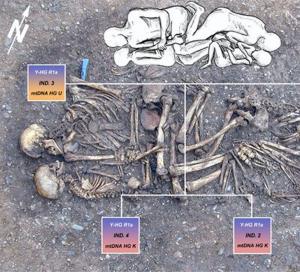A Stone Age massacre has provided evidence of the earliest known nuclear family. The evidence also suggests that, just like today, some early humans lived in blended families.
Archaeologists have long suspected that people lived in nuclear families at least as far back as the Stone Age. The idea even has a foothold in popular culture - remember Fred, Wilma and Pebbles Flintstone?

© National Academy of Sciences/PNASA Late Stone Age family grave, showing the careful arrangement of bodies. The photo is overlain by a pedigree reconstructed from the genetic results with squares denoting male.
But the evidence for Stone Age nuclear families has been flimsy, mainly based on extrapolations from how we live now, and speculations about relationships between adults and children found buried together.
"We have been inferring the past from the present, but it wasn't necessarily true. Now, we have tested the hypothesis and found that at least one Stone Age nuclear family existed," says Wolfgang Haak who led a team at Johannes Gutenberg University in Mainz.


